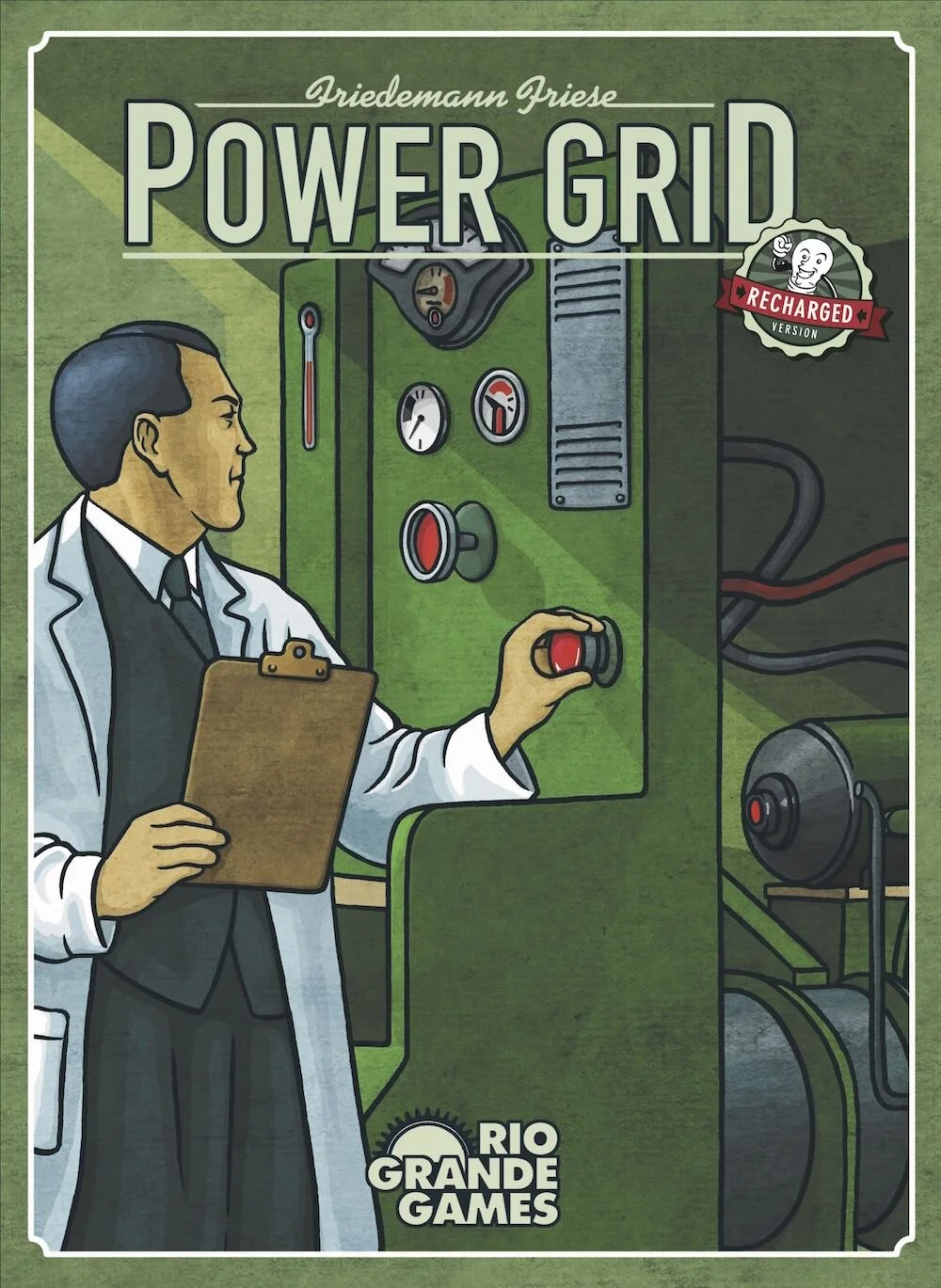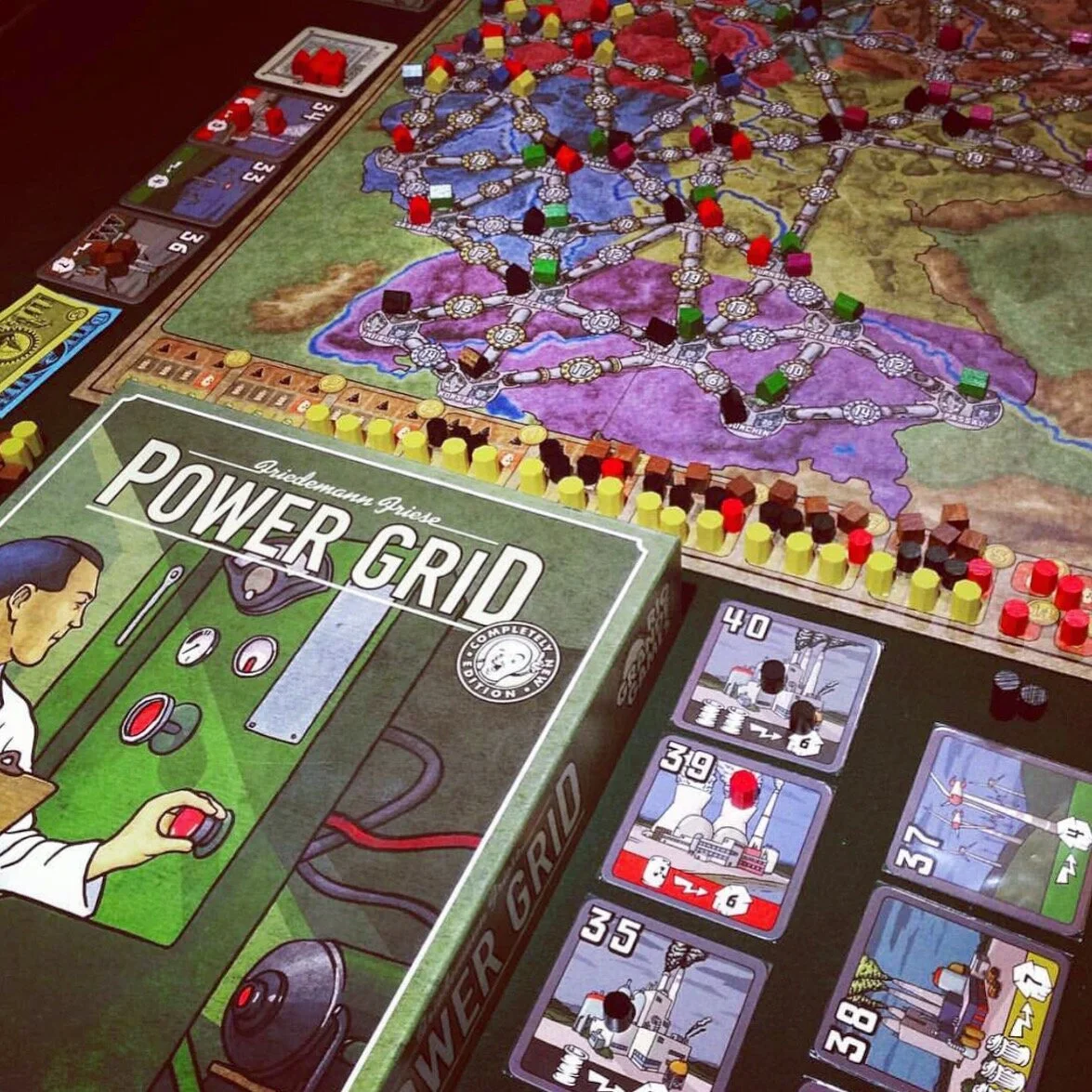~ Overview ~
In a fair proportion of games, I can write about specific strategies to employ: Stone Age’s “Starvation Strategy”, Puerto Rico’s shipping vs. building - Power Grid really doesn’t lend itself to such specific strategies. It is a game of situational awareness and adaption to circumstances. The key is recognizing the game state and what needs to be done, both at that moment and for the following turns. What you want to do at a given point in the game will depend on accessing supplies, opportunities for expanding your grid, power plant acquisition, how many players are in the game, the specific map you are playing, and how far along the game has progressed. It is a game that rewards experience, can ruthlessly punish mistakes, and the clear answer on what to do in a given situation isn’t always clear, even to an extremely experienced player.
~ Initial Placement of Power Plants ~
With something like 20 maps, it becomes impossible to give any specific advice beyond the most general. You want to place such that you both have as much access to the rest of the map as possible while fencing off enough cities to be able to get to Stage Two on your own - getting fenced in with four or five cities can leave you falling behind for an extended period if the power plant market stagnates. Leave too many cheap connections, and someone might go directly inside of you, cutting you off from your interior lines while others cut you off from exterior lines.
While it is generally better to be at the minimum number of cities that you can run so that you have a favorable position in the turn order, at the start, you might consider taking more than absolutely necessary. If you take a set of two or three cities with very cheap connections, you can reserve a smaller, less tempting set of cities behind your position that discourages poaching. This works well when you start with higher numbered power plants that can power two cities.
The other thing to consider is not conceding too much territory to a single player. If you are last or second to last in choosing your starting spot, you must keep an eye out not just for yourself, but also put pressure on other players - it’s an advantage that can carry them a long way if you allow it.
~ Turn Order and Sandbagging to Victory ~
Power Grid is a difficult game to win by simply taking the lead and holding it throughout the game. There are pitfalls, but it can be done as long as you plan ahead and are getting a sufficient enough lead in money every turn. However, it doesn’t happen often, and not something you can really plan on. Money is power, but turn order has more options.
The game has a built-in catch-up feature: the player ostensibly “winning” is the one with most power plants, or highest numbered plant in the event of a tie. That player has to make decisions on buying a power plant before other players, acquires supplies after the other players, with rising costs or disaster of disasters, risking the market being wiped out, and gets to sit and watch the best city connections disappear in front of their turn. The only real advantage the first player has is that they can control their own position easier for the next turn by seeing how many cities other players have committed to. This can be decisive on the final turn of the game, but more about that in the Endgame section.
~ Power Plants ~
“I can’t pass fast enough”
- Battle Cry of a Tournament Player
There are several important considerations when buying a power plant: initial cost, type of fuel and it’s cost and availability (which can change radically depending on the map), the number of cities it can power, and one more consideration that isn’t printed on the card: whether it is “permanent” or not (will you need to eventually replace it). The last consideration changes with the number of players, and may be a decisive one. With three or four players, the endgame is triggered at 17 cities in your grid, powered or not. To get to 17, you probably need a plant that can power at least five cities for it to last through until the end of the game without needing replacement. You might be able to get away with a four, but it puts pressure on simply having a large power plant available when you need to buy, and someone else may also need it, and you end up in a debilitating bidding war. Further, the earlier you acquire a plant that you don’t need to replace, the more options you have down the road to wait for better plants to appear. This is because you can only buy one power plant in a given turn. If you have one out of three done already, you can get to where you need to in two more buys, rather than three. That can potentially be the difference between first and last place. With five players, you might well be able to make a 4 plant survive to the end, and even a three, since you only need 15, and with six players, maybe even a 3. Further, these are theoretical needs based on being able to power up the minimum required to trigger the endgame - you don’t actually have to have that many if the game turns the right way.
The other consideration for end game power plants is fuel. Not just at the moment that you acquire it, but in future phases when the supply increases or decreases, and what other players have or are likely to have. Three players with power plants vital to their victory all needing three coal (total of nine) when the game shifts to Step 3 and maybe only four coal are being produced each turn. You may want to bid more on another plant that doesn’t have such inherent dangers and costs.
~ Things to value in buying power plants ~
Your position in the turn order: if a juicy plant is in the preview row, you might be able to just not bid on current plants, in the hopes you get the plant you want and need. Remember, the last person to have to nominate a power plant for auction gets it for face value. Also realize that if someone has to nominate a plant, they have to put in a minimum bid, and if you overbid them, they will pass as fast as possible and then have a chance at a better plant. Don’t let them off the hook if you have better options yourself.
Efficiency: maybe the plant is a little smaller than you want, but runs on one oil rather than three coal. This can save you a lot of money in the long run.
~ Step Transition ~
The big question, is it better to initiate the transition yourself or let someone else do it? If you have more powered cities than anyone else, and it might continue that way, you are gaining more income and a bigger lead. If you can grab a large number of cities and no one else can respond until the next turn, it might be best to do so and get those strategic or cheap connections while you can. The opposite method is to be in a favorable position on the turn order so that you can first, and can rush into the key and newly opened second phase sites.
~ Fuel and Shortages ~
You need to be aware of the specific fuel refresh rates of the map you are playing, and how that changes with Step 2 and 3. To complicate that, you have to keep track of what the other players need if that conflicts with what you have, and your order of buying within the turn. If someone else is taking their turn, you should be using that down time to figure out what will be available, how much you need, how much that will leave you to buy a power plant, how much money you’ll have to expand your grid, and whether or not you really want to do any of that. Situational awareness.
You can store two sets of fuel on your power plant, and can stock away extra on plants that use similar fuel if you need to. The down side of this is you have tied up money that is just sitting there. Others can do the same, and you need to consider what will happen if they do. If you don’t, thinking there’s plenty of fuel for next round, and they all decide to stock up, you may either end up short or find that you don’t dare expand the number of cities you have in your grid, or you’ll end up short anyway. When you are approaching the end game, it may become a critical decision on whether you even want to power a plant - on the final turn, you need to power as many cities as you can, and if there is a fuel shortage, you may have to take less money up front in order to be able to power for maximum city count on the last turn. Which leads us to...
~ End Game ~
The end of the game is triggered by anyone building to the minimum required by the number of players in the game. You don’t have to actually power anything to trigger the end, and that becomes the dangerous dance - can anyone build enough to trigger the end game, will they even if they can, and what you can do from there. This is when going last in the building sequence may be to your advantage. You may not know precisely how much money your opponents may have, but you should be paying attention to whether they bought power plants, spent for double fuel loads, how much money they made last turn, and at least have a rough idea of what they have to build with.
The key to winning at this point is understanding whether you can brute force your way to victory with bigger power plants, more money, and with it, more powered cities than everyone else, or build up to the minimum to trigger end game, and power more than everyone else. The keys to the end game are securing the fuel you need, understanding whether you need to be bidding on that big power plant, or going with what you have or something not so big while retaining the tactical advantage of retaining enough money to increase your city grid enough to trigger the end of the game.
~ Establish if the Game Will End in One or Two Turns ~
Your strategy is dependent on this, and you need to be aware of this choice two turns away if at all possible. Do not let the end of the game surprise you. If the game will not end this turn, you need to make sure you will have fuel for two turns available. If the market is bought out in front of you because you didn’t buy fuel for two turns, or didn’t position yourself early in the turn order so you can buy the fuel before it is bought out, you may have to not run a power plant, possibly by choice. If you figure that you can only secure enough coal, for example, for a single powering of your plant, you may need to pass on powering that plant (you are not required to power it up). Why? You absolutely need to power everything you have the last turn, and this may require foregoing some money on the preceding turn. It’s a last ditch measure, but one you may need to make. At the same time, buying enough fuel for two turns when it is going to end in one expends money that could otherwise by used to buy more city placements, or cripples your money in case of a tie.
I usually try to establish how much money it will take for me to trigger the end game. Say that I’m at 13 cities, and the end game requires 17. Okay, four cities... Then work out how much it will take to connect those four cities. You can do it precisely, or work out a rough figure - for example, all cities left are at 20, and the connections are going to average around 10, so 30 per city. Do you have 120 Elektros or not? Will you have 120 Elektros after buying any power plants and fuel you need? If I have the money, I have the option of ending the game. If I don’t, I have to decide if someone else is going to be able to do it, or if that is a chance I’m willing to risk. You need to have at least some rough guesstimate if some other player can end the game, because that will dictate whether you go all in for this turn, or optimize for next turn.
~ Situational Awareness ~
The best way to sneak out a victory against the odds is the surprise early ending, where everyone is positioning themselves for another turn, and you surprise them by buying enough cities to trigger the end. The way to do that is retain enough money to buy out to the limit, and position yourself as late as possible in the turn order. With everyone else sand-bagging to go early in the turn order for it’s advantages on fuel and city placement, it may be easy to do. If you are last in turn order, you can see how many cities people can power up - if you can get to the most and trigger the end of the game, it won’t matter that they can power 17 or 18. If you do it early in the turn order, others are now aware that the game is ending and will go all out rather than sand-bag for turn position, so be aware of players moving after you that may have the potential to tie your city count - you spent a huge amount of money to buy the extra cities that they won’t have to. Just because you can trigger end game doesn’t necessarily mean you should!
The way to defend against this if you are early in the turn order: make sure you buy enough cities (that you can power) to prevent someone late in the turn being able to power more than you. This may require sacrificing turn order - which you may not be able to do if you have potential fuel acquisition difficulties. You just need enough to match what they can power - if they buy enough cities to trigger the end game, they’ll have drained their cash reserves, and you can win on the tie-breaker.
And in the End…
If this all seems overwhelming - you are not alone! Even the best Power Grid players over-bid on what they think is a key plant, or underbid and sweat it out hoping against hope that a key power plant shows up to bail them out. It is not any easy game to master, and there is no substitute for experience. Thinking ahead, planning your turn while others are taking theirs, and being aware of how close the end game is will prepare you to take the right steps at the right time.
-Bruce
(A little background about Bruce - Bruce Schlickbernd has won the official Power Grid World Tour Tournament at StrategiCon three times over the past decade. He currently resides in Santa Clarita, CA)
Power Grid is designed by Friedemann Friese and published by Rio Grande Games in USA.
You can watch our Power Grid strategy interview with Bruce here:


